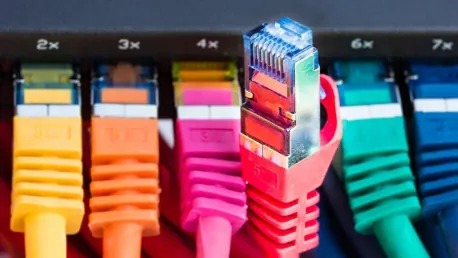In today’s digital age, countless devices utilize Wi-Fi for internet connectivity, offering unparalleled convenience. From smart TVs to e-readers, wireless technology has revolutionized how people access online content. However, for gamers, particularly those using the latest consoles like the PlayStation 5 (PS5) and Xbox Series X, the debate between Wi-Fi and Ethernet connections is ongoing. This article explores the tangible benefits of using an Ethernet connection for gaming.
The Shift from Wired to Wireless
The Rise of Wireless Convenience
The proliferation of Wi-Fi technology has transformed the way people connect to the internet. With an array of devices relying on wireless connectivity, the convenience factor is undeniable. Not having to deal with cables and wires while still enjoying robust internet access has become a norm in most households. Modern homes are equipped with multiple gadgets that benefit from the ease and flexibility Wi-Fi provides, making it an integral part of everyday life.
However, the convenience of wireless technology should not overshadow the critical needs of specific applications. While Wi-Fi is sufficient for general browsing, content consumption, and light online activities, certain tasks demand more than just convenience. High-speed, low-latency connections are essential for applications where data integrity and real-time responsiveness are crucial. This is particularly true in the realm of online gaming, where milliseconds can make a significant difference.
Enduring Value of Wired Connections
Despite the convenience of Wi-Fi, wired connections maintain a strong presence, particularly in scenarios where stability and consistency are crucial. Ethernet connections offer a steadfast alternative, often delivering superior performance for specific applications, such as gaming. For users seeking reliable and uninterrupted internet access, the assurance of a wired connection can be indispensable.
Moreover, the technological advancements in wired networking have kept Ethernet relevant amidst growing wireless options. Ethernet cables are capable of supporting high bandwidths and can handle large data transfers more efficiently than Wi-Fi. This robustness ensures that once connected, users are less likely to experience drops in connection or fluctuations in speed, which are common with wireless networks. These advantages become immediately apparent in demanding environments such as competitive online gaming platforms and intensive streaming services.
Gaming Performance and Ethernet
Enhanced Gaming Experience
For avid gamers, especially those with top-tier consoles like PS5 and Xbox Series X, an Ethernet connection can profoundly improve the gaming experience. By switching from Wi-Fi to a wired connection, several gamers have reported noticeable differences in gameplay fluidity and download times. The lower latency and higher bandwidth of Ethernet connections ensure that data packets are transmitted quickly and consistently, leading to a reduction in lag and smoother real-time interactions.
The impact of this improved performance is multifaceted. Faster response times allow gamers to react swiftly to in-game events, which is critical in competitive scenarios. Enhanced download speeds mean less waiting for game updates and content downloads, allowing more time for actual gameplay. Streaming content, whether for gaming or other forms of entertainment, also benefits from the uninterrupted, high-speed transfer rates that Ethernet provides. This combination of factors can significantly boost the overall gaming experience, making wired connections highly desirable for serious gamers.
Stability and Network Performance
Ethernet connections offer unparalleled stability compared to Wi-Fi, which can be prone to interruptions and interferences. This stability translates to fewer disruptions during gaming sessions, ensuring a more seamless and enjoyable experience. Wi-Fi signals can be affected by various physical and electronic interferences, such as walls, other wireless networks, and household appliances, which can lead to inconsistent connection quality.
In contrast, Ethernet cables provide a direct link to the network, effectively eliminating the potential for such disruptions. This ensures that the connection remains stable throughout extended gaming sessions. Furthermore, the predictability and reliability of Ethernet are particularly beneficial in environments where multiple devices are connected to the network simultaneously. While Wi-Fi might struggle to maintain consistent speeds when numerous gadgets are online, Ethernet connections are less susceptible to bandwidth sharing issues, providing a steady and continuous data flow.
Wi-Fi Versus Ethernet: Key Considerations
Consistent Speed and Reduced Latency
One of the significant advantages of Ethernet over Wi-Fi is the consistent and stable speed it offers. This consistency is critical for downloading large game files and streaming activities, where speed fluctuations can lead to frustrating delays and interruptions. Wi-Fi speeds can be affected by signal strength, distance from the router, and the number of connected devices, leading to variable performance.
Ethernet connections, on the other hand, maintain a fixed data rate, ensuring that users receive the best possible speed their internet plan supports. This predictability is invaluable for gaming, where uninterrupted high-speed access is crucial. For instance, downloading a large game or streaming 4K content requires a stable connection to avoid issues like buffering and extended download times. Ethernet’s ability to provide consistent high-speed connectivity makes it the preferred choice for these tasks, offering users a more reliable and efficient internet experience.
Low Latency Importance
For online gaming, low latency is paramount. Latency, the time it takes for data to travel from the console to the game server and back, is drastically minimized with an Ethernet connection. This reduction is essential for an optimal gaming experience, where even milliseconds can impact gameplay. High latency, often experienced with Wi-Fi, can result in lag, making games less responsive and putting players at a disadvantage in competitive scenarios.
Ethernet connections help achieve the lower latency needed for real-time gaming. This is especially crucial for fast-paced games where quick reflexes and immediate actions are necessary. Gamers often encounter fewer latency-related issues, such as lag spikes and delayed actions, with a wired setup. Hence, the choice between Wi-Fi and Ethernet can significantly affect the quality of online gaming. Ethernet offers a clear edge in terms of speed and reliability, which are critical for delivering a seamless and competitive gaming experience.
Streaming and Downloading Benefits
High-Fidelity Streaming
Ethernet connections are also beneficial for users of high-end smart TVs and those streaming extensive content. Reduced buffering and improved reliability help deliver a superior viewing experience, echoing the benefits seen in gaming scenarios. Streaming services require consistent data throughput to deliver high-definition and 4K content without interruptions.
Wi-Fi networks, although capable, can sometimes fall short of this requirement, especially in environments with heavy network traffic or interference. An Ethernet connection mitigates these issues, providing a stable and dedicated pathway for data transmission. Consequently, viewers can enjoy uninterrupted streaming sessions, be it for movies, shows, or live broadcasts. The uniformity and dependability of Ethernet become particularly valuable when multiple devices in a household are concurrently accessing the network, ensuring everyone experiences high-quality streaming without compromise.
Enhanced Download Speeds
A wired connection can lead to faster downloads and smoother streaming capabilities. These improvements are particularly useful for gamers downloading large game updates or engaging in multiplayer modes that demand high-speed internet. The higher data transfer rates of Ethernet ensure that large files, such as game patches and updates, are downloaded more efficiently, reducing the wait time for gamers eager to play.
Furthermore, the stability provided by Ethernet connections means fewer interruptions and hiccups during downloads, leading to a more reliable process overall. This is crucial for maintaining the user experience, especially when dealing with substantial downloads. Multiplayer gaming also benefits significantly from the enhanced stability and speed of Ethernet. Real-time data exchange and consistent connectivity are critical in these settings, and Ethernet provides the necessary performance to support such demanding activities.
Challenges and Solutions
Practical Setup Considerations
Implementing an Ethernet connection can sometimes present practical challenges, especially in terms of cable management. Routing cables through a living space can be cumbersome, and not all users may have their routers conveniently located near their gaming or entertainment setups. However, the advantages in performance often outweigh these logistical hurdles, leading many to seek creative solutions.
One potential solution is relocating the router to a central position within the home to ensure that it is close enough to key devices. Using network switches can also help, allowing for multiple devices to be wired via Ethernet without the need for individual cables running directly to the router. Additionally, for those who find cable management daunting, there are various aids and tools available to help organize and conceal wires, keeping the setup both functional and aesthetically pleasing.
Wi-Fi 6: A Competent Alternative?
Modern Wi-Fi 6 routers can deliver impressive speeds and reduced latency, addressing many concerns gamers might have with older Wi-Fi standards. Wi-Fi 6 offers features like improved capacity, better performance in congested environments, and enhanced battery life for connected devices. These advancements make Wi-Fi 6 a viable alternative for those unable to use a wired connection, though it may still fall short in specific scenarios.
While Wi-Fi 6 routers provide substantial improvements over previous generations, they may not entirely match the consistency and low latency provided by Ethernet. For some users, this technology will suffice, offering a blend of impressive performance and wireless convenience. However, for the most demanding users, particularly competitive gamers and intensive streamers, the benefits of Ethernet might still prove unmatched. Thus, the decision between Wi-Fi and Ethernet ultimately depends on the specific needs and priorities of the user.
The Verdict for Gamers
First-Hand Experiences
Drawing from personal experiences, the article highlights the substantial improvements noticed when switching to an Ethernet connection. The enhanced gameplay quality and reduced download times underscore Ethernet’s advantage for serious gamers. By connecting directly to their network, gamers can maximize their online performance, experiencing fewer lags and timeouts and maintaining a competitive edge in their gameplay.
Testimonies from gamers who have transitioned to Ethernet reveal a marked difference in performance. Many cite significant reductions in latency and notable improvements in overall connection stability. These enhancements not only contribute to better gaming outcomes but also enrich the overall gaming journey, contributing to greater enjoyment and satisfaction. The firsthand accounts strongly endorse the value of Ethernet for gaming enthusiasts willing to invest in the ultimate gaming performance.
Balancing Convenience and Performance
While Wi-Fi offers unmatched convenience, the stability and performance of Ethernet cables cannot be undermined. For gamers seeking the utmost in stable and responsive internet access, the shift to an Ethernet connection is often well-justified. While the ease and flexibility of Wi-Fi cater to a wide range of everyday needs, dedicated gaming and streaming demand the uncompromised quality that only an Ethernet connection can ensure.
Balancing the benefits of each connection type involves assessing individual requirements and environments. For users heavily involved in competitive gaming or where high-stakes performance is crucial, Ethernet remains the gold standard. Conversely, for those who prioritize mobility and ease of use, and who perhaps have their router in an optimal location or use Wi-Fi 6 technology, a wireless setup might suffice. Each scenario highlights the necessity of evaluating both convenience and performance to make an informed choice that best matches one’s digital lifestyle.
Conclusion
In the modern digital age, a multitude of devices rely on Wi-Fi for internet access, offering unequaled convenience. From smart TVs and laptops to e-readers and smartphones, wireless technology has transformed the way individuals access online content. Despite this widespread reliance on Wi-Fi, gamers, especially those using cutting-edge consoles such as the PlayStation 5 (PS5) and Xbox Series X, continue to debate the merits of using Wi-Fi versus Ethernet connections. This article delves into the specific advantages of opting for an Ethernet connection when gaming. By examining factors like reduced latency, stabilized connections, and enhanced security, it becomes clear that Ethernet offers a superior gaming experience. Whether you’re downloading large updates or engaging in online multiplayer matches, Ethernet connections ensure smoother gameplay and minimize disruptions. While Wi-Fi’s convenience is unmatched, Ethernet’s reliability makes it the preferred choice for serious gamers who demand the best performance from their gaming setups.









